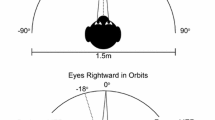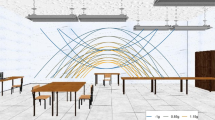Abstract
Saccade planning requires a geometric transformation between the retinal stimulus position and the desired motor plan to acquire the target. This reference frame transformation problem has, however, never been considered for velocity signals. Therefore we asked whether a separate 3D visuomotor transformation of velocity signals was theoretically required by modeling the underlying geometry. We used quaternions to model the 3D eye-in-head geometry. Our model predicted that a visuomotor velocity transformation would require extra-retinal 3D eye-in-head position to convert the retinal velocity input into spatially accurate behavior and includes three different components; (1) the same retinal velocity results in different eye rotation axes depending on eyein-head position, (2) false torsion due to off-axes eye positions must be compensated for and (3) ocular torsion (e.g. due to the VOR) must be accounted for. To test these predictions, subjects were required either to pursue a moving target viewed under different vertical (prediction 1) or oblique (prediction 2) eye positions, or viewed under different head roll angles generating VOR-induced eye torsion (prediction 3). We measured 3D eye and head orientation and analyzed the openloop gaze pursuit response, i.e. the first 100ms after pursuit onset. We then compared the observed pursuit response to the predictions of the model: if no transformation was performed, pursuit direction should best correlate with the retinal target movement direction; a complete 3D velocity transformation would be reflected in spatially accurate pursuit. We found that for all 3 predictions, the direction of pursuit initiation was spatially accurate and did not follow the retinal (no transformation) hypothesis. This suggests that the brain performs a complete 3D visuomotor velocity transformation for smooth pursuit eye movements that is different from the previously described visuomotor transformation of position signals for saccades.
Access this chapter
Tax calculation will be finalised at checkout
Purchases are for personal use only
Preview
Unable to display preview. Download preview PDF.
Similar content being viewed by others
References
Badler JB, Heinen SJ (2006) Anticipatory movement timing using prediction and external cues. J Neurosci 26:4519–4525.
Blohm G, Crawford JD (2007) Computations for geometrically accurate visually guided reaching in 3-D space. J Vis 7:1–22.
Blohm G, Khan AZ, Crawford JD (2008) Spatial transformations for eye-head coordination. In: New Encyclopedia of Neuroscience. Oxford: Elsevier.
Bockisch CJ, Haslwanter T (2001) Three-dimensional eye position during static roll and pitch in humans. Vision Res 41:2127–2137.
Carl JR, Gellman RS (1987) Human smooth pursuit: stimulusdependent responses. J Neurophysiol 57:1446–1463.
Crawford JD, Guitton D (1997) Visual-motor transformations required for accurate and kinematically correct saccades. J Neurophysiol 78:1447–1467.
Crawford JD, Medendorp WP, Marotta JJ (2004) Spatial transformations for eye-hand coordination. J Neurophysiol 92:10–19.
Haslwanter T, Straumann D, Hess BJ, Henn V (1992) Static roll and pitch in the monkey: shift and rotation of Listing’s plane. Vision Res 32:1341–1348.
Krauzlis RJ (2004) Recasting the smooth pursuit eye movement system. J Neurophysiol 91:591–603.
Krauzlis RJ, Miles FA (1996) Release of fixation for pursuit and saccades in humans: evidence for shared inputs acting on different neural substrates. J Neurophysiol 76:2822–2833.
Mikami A, Newsome WT, Wurtz RH (1986) Motion selectivity in macaque visual cortex. II. Spatiotemporal range of directional interactions in MT and V1. J Neurophysiol 55:1328–1339.
Orban GA (2008) Higher order visual processing in macaque extrastriate cortex. Physiol Rev 88:59–89.
Priebe NJ, Lisberger SG, Movshon JA (2006) Tuning for spatiotemporal frequency and speed in directionally selective neurons of macaque striate cortex. J Neurosci 26:2941–2950.
Segraves MA, Goldberg ME, Deng SY, Bruce CJ, Ungerleider LG, Mishkin M (1987) The role of striate cortex in the guidance of eye movements in the monkey. J Neurosci 7:3040–3058.
Snyder LH (2000) Coordinate transformations for eye and arm movements in the brain. Curr Opin Neurobiol 10:747–754.
Tweed D (1997) Three-dimensional model of the human eye-head saccadic system. J Neurophysiol 77:654–666.
Author information
Authors and Affiliations
Corresponding author
Editor information
Editors and Affiliations
Rights and permissions
Copyright information
© 2009 Springer-Verlag Berlin Heidelberg
About this paper
Cite this paper
Blohm, G., Daye, P., Lefevre, P. (2009). Transforming retinal velocity into 3D motor coordinates for pursuit eye movements. In: Vander Sloten, J., Verdonck, P., Nyssen, M., Haueisen, J. (eds) 4th European Conference of the International Federation for Medical and Biological Engineering. IFMBE Proceedings, vol 22. Springer, Berlin, Heidelberg. https://doi.org/10.1007/978-3-540-89208-3_15
Download citation
DOI: https://doi.org/10.1007/978-3-540-89208-3_15
Publisher Name: Springer, Berlin, Heidelberg
Print ISBN: 978-3-540-89207-6
Online ISBN: 978-3-540-89208-3
eBook Packages: EngineeringEngineering (R0)




